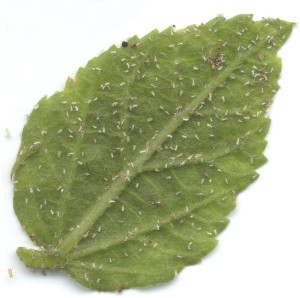Aphids on Ornamentals
 Hosts
Hosts
Nearly all species of plants have one or more aphid species that feed on them. Many species feed on one or a few closely related species of plants. Therefore, knowing the host plant is often helpful in identification. Only a few species, such as the green peach aphid, feed on a large number of unrelated hosts.
Symptoms
Aphids usually prefer to feed on succulent young shoots and leaves, although some species occur on flowers, twigs, branches, or even roots. They seldom kill plants, but their feeding can cause stunted plant growth, curled and yellowed leaves, or distorted stems and fruits; some species cause galls on roots, leaves, or stems. Damage results primarily from the loss of plant juices, although some aphid species transmit plant viruses or inject toxins into plants while feeding. Aphids, and certain other plant sap sucking insects, excrete large amounts of honeydew, a sticky substance often seen on leaves, pavement, automobiles, or other surfaces below infested foliage. Honeydew consists mainly of excess sugar ingested by the insects and passed through the body. Ants are often attracted to the sugary honeydew and occasionally tend the aphids much as man tends cattle; some ants even carry aphids to new plant parts to establish more colonies. Honeydew also attracts flies, wasps, and bees, thus adding a nuisance element for humans. A black sooty mold often grows on plant parts covered with honeydew. This fungus can detract from the plant's appearance and reduce the amount of light reaching leaves (thus reducing photosynthesis).
Life Cycle
The "typical" aphid species may produce several wingless generations in the spring, followed by a generation of winged forms. The winged forms can fly to other plants where many more wingless summer generations may be produced. As days become shorter and cooler, a generation of winged aphids may be produced which fly back to the winter host. Some aphids have distinct winter and summer hosts (the winter host may be an evergreen and the summer host an annual weed or deciduous plant). Aphids can increase rapidly in an extremely short time. During warm weather some species can complete a generation in less than two weeks. In many species, most or all of the summer generations consist of females which give birth to live female young, and are produced without sexual reproduction (parthenogenesis). Males may be produced near the end of the season. The overwintering stage may be eggs or the adults may be active through the winter.
Description
Aphids are small (usually 1/8 inch long or less), delicate, more or less pear-shaped insects with long legs and antennae. Their color can vary from green to brown to red or black. They may be winged or wingless, but wingless forms are more common. Most aphids have a pair of tube-like structures, called cornicles, projecting backwards near the rear of the body. They have piercing-sucking mouthparts and feed by sucking sap from plant tissue.
Control
Please contact your local county extension office for current information.

